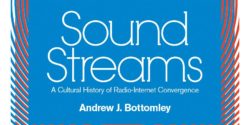Subscribe: Spotify | TuneIn | RSS | More
Internet radio was born more than 25 years ago, yet, according to Edison Research, only in the last month has the medium garnered just 10% of all broadcast listening time in the US. We might lay at least some blame on the commercial radio industry, which didn’t embrace it until well into the 2000s, long after the college, community and public radio trailblazers.
Prof. Andrew Bottomley returns to the show to help us understand the reasons behind mainstream broadcasters’s delayed acceptance, and explore why college broadcasters were at the forefront. His new book is “Sound Streams: A Cultural History of Radio-Internet Convergence,” detailing the first comprehensive history of online streaming audio.
We also discuss the similarities between long-distance listening, a/k/a DXing, and internet radio, and how the societal changes wrought by COVID-19 are affecting online radio and podcasting.
Show Notes:
- University of Michigan Press – Sound Streams: A Cultural History of Radio-Internet Convergence
- “Sound Streams” at Amazon
(Radio Survivor will receive a small affiliate commission if you buy through this link) - Andrew Bottomley’s website
- Andrew was the guest on: Podcast #167 – Alternative Histories of Podcasting
- Edison Research: Streaming accounts for 10% of broadcast radio’s consumption during covid-19 disruptions



